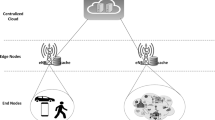Abstract
The objective of the paper is to construct a backbone node with self organization, topology control and reconfiguration capabilities. The key issues in wireless networks are maintain a topology with minimum degree, self organization during link or node failure and reconstruction ability when the backbone changes the position. Existing research works concentrate on any one of the issues by a backbone, but nodes in wireless are battery operated. To solve the all issues separately more power is required. To overcome the existing issues we propose a localized approach namely STAB-WIN, which will solve all the issues without affecting the entire system performance using local updates. This research work focuses on multiservice ability of a node to meet the design goals of next generation networks. Our approach is witnessed by the simulation results on analyzing the parameters like scalability which includes backbone size, routing overhead, control transfer and QoS parameters.
Similar content being viewed by others
References
Sinha, P., Sivakumar, R., & Bhargavan, V. (2001). Enhancing ad hoc routing with dynamic virtual infrastructures. In Proceedings of IEEE INFOCOM ‘01 (pp. 1763–1772).
Tseng Y. C., Ni S. Y., Chen Y. S., Sheu J. P (2002) The broadcast storm problem in a mobile ad hoc network. Wireless Networks 8(2-3): 153–167
Lee, S., Levin, D., Gopalakrishnan, V., & Bhattacharjee, B. (2007). Backbone construction in selfish wireless networks. In Proceedings of ACM international conference on measurement and modeling of computer systems (Sigmetrics ‘07) (pp. 121–132).
Blum J., Ding M., Thaeler A., Cheng X. (2004) Connected dominating set in sensor networks and MANETs. Kluwer, Dordrecht, pp 329–369
Ruan L., Du H., Jia X., Wu W., Li Y., Ko K. (2004) A greedy approximation for minimum connected dominating sets. Theoretical Computer Science 329: 325–330
Cheng X., Ding M., Du D.H., Jia X. (2006) Virtual backbone construction in multi-hop ad hoc wireless networks. Wireless Communications and Mobile Computing 6: 183–190
Wan P. J., Alzoubi K.M., Frieder O. (2005) Distributed construction of connected dominating sets in wireless ad hoc networks. ACM Kluwer Mobile Networks and Applications (MANET) 9(2): 141–149
Teymoori, P., & Yazdani, N. (2008). Local reconstruction of virtual backbone to support mobility in wireless ad hoc networks. In IEEE international symposium on telecommunication (pp. 382–387).
Dai F., Wu J. (2004) An extended localized algorithm for connected dominating set formation in ad hoc wireless networks. IEEE Transaction on Parallel and Distributed Systems 15(10): 908–920
Yang H. Y., Lin C. H., Tsai M. J. (2008) Distributed algorithm for efficient construction and maintenance of connected K-hop dominating sets in mobile ad-hoc networks. IEEE Transactions on Mobile Computing 7(4): 444–457
Park, M., Wang, C., Wilson, J., Thai, M. T., Wu, W., & Farrago, A. (2007). A dominating and absorbent set in wireless ad-hoc networks with different transmission range. In Proceedings of ACM MobiHoc (pp. 22–31).
Hameed El-Afandi, H., hosseini, H., & Vairvan, K. (20 06). A wireless ad hoc protocols comparison study: DSR, AODV and IWAR. Journal of Computational Methods in Sciences and Engineering, 6(5, 6 Suppl. 1), 181–190.
Yu, W., & Lee, J. (2002). DSR based energy-aware routing protocols in ad hoc networks. In Proceedings of 2002 international conference on wireless networks.
Bao, L., & Garcia-Luns Aceves, J. (2003). Topology management in ad hoc networks. In Proceedings of ACM MobiHoc‘03 (pp. 129–140).
Chen B., Jamieson K., Balakrishnan H., Morris R. (2002) SPAN: An energy-efficient coordination algorithm for topology maintenance in ad hoc wireless networks. ACM Wireless Networks Journal 8(5): 481–494
wattenhofer, R., Li, L., Bahl, P., & Wang, Y. M. (2001). Distributed topology control for power efficient operation. In Multihop wireless ad hoc networks. Infocom (pp. 1388–1397).
Hedetniemi S. M., Hedetniemi S. T., Jacobs D. P., Srimani P. K. (2003) Self-stabilizing algorithms for minimal dominating sets and maximal independent sets. Computers and Mathematics with Applications 46(5–6): 805–811
Wu J., Lou W. (2003) Forward-node-set-based broadcast in clustered mobile ad hoc networks. Wireless Networks and Mobile Computing 3(2): 155–173
Yang, S., Wu, J., & Cao, J. (2005). Connected k-hop clustering in ad hoc networks. In Proceedings of 34th international conference parallel processing (ICPP‘05) (pp. 373–380).
Smys, S., Bala, G. J., & Raj, J. S. (2009). Construction of virtual backbone to support mobility in MANET—A less overhead approach. In 3rd IEEE conference on application of information and communication technology, AICT 2009 (pp. 1–4). Baku, Azerbaijan.
Author information
Authors and Affiliations
Corresponding author
Rights and permissions
About this article
Cite this article
Smys, S., Bala, G.J. STAB-WIN: Self Organized, Topology Control Ability Backbone Node in Wireless Networks. Wireless Pers Commun 63, 529–548 (2012). https://doi.org/10.1007/s11277-010-0148-8
Published:
Issue Date:
DOI: https://doi.org/10.1007/s11277-010-0148-8




